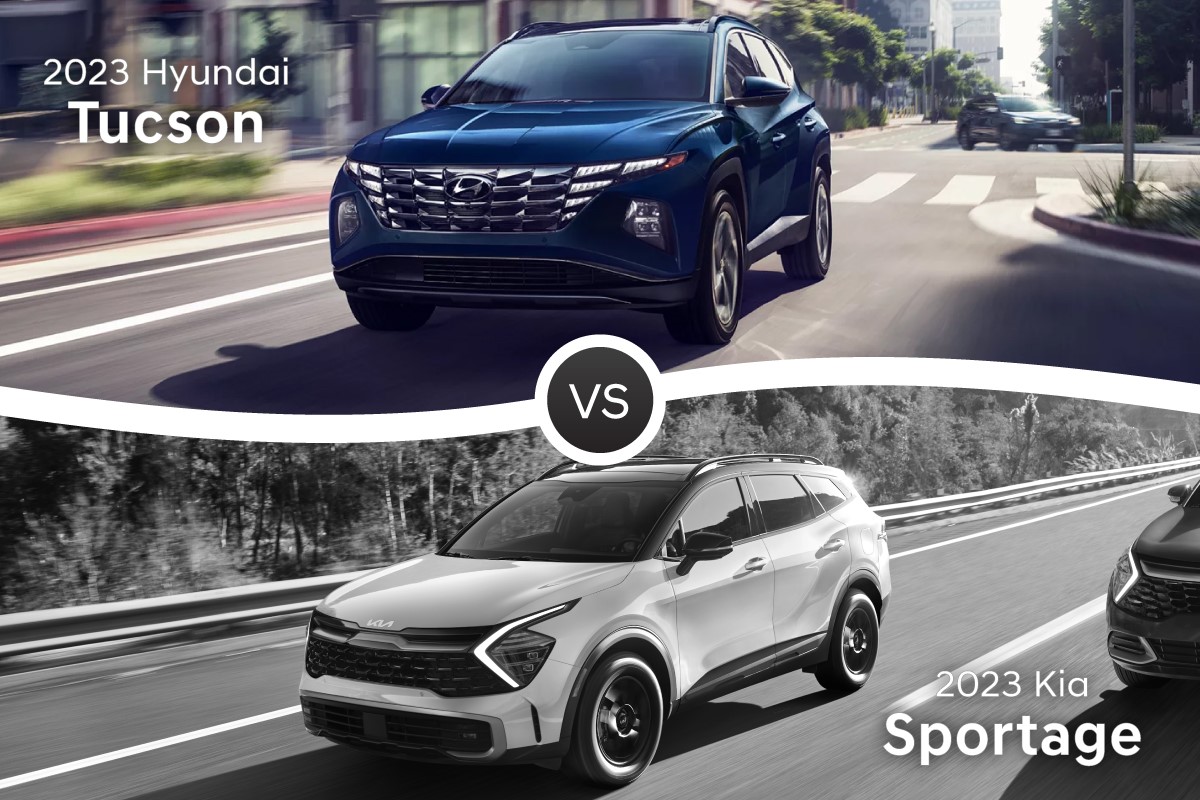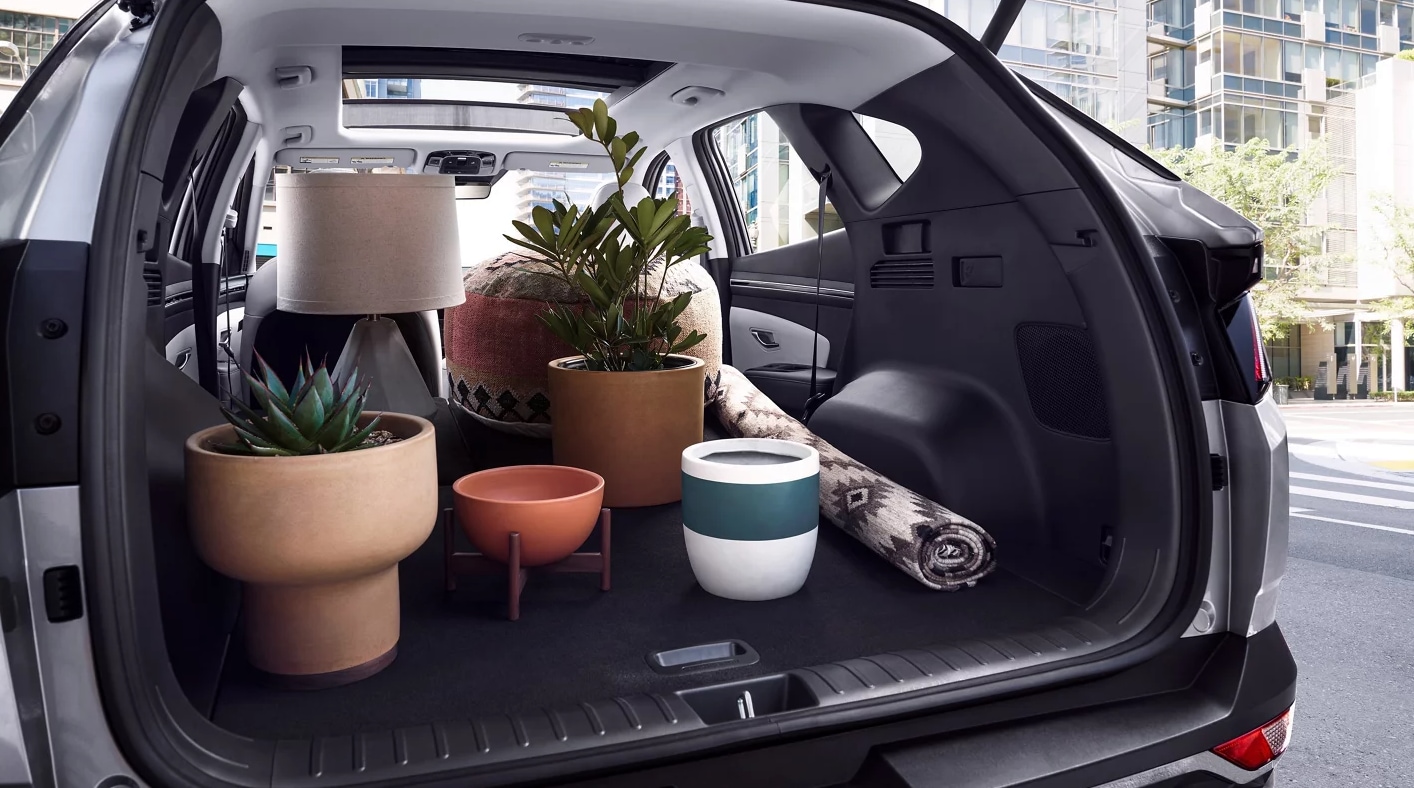
Many people have cousins. Some cousins resemble each other (kinda, sorta). Some don't at all. But there are rare instances in which two cousins look so darn alike, they could be twins. That's the Hyundai Tucson and Kia Sportage in a nutshell—at least on their spec sheets.
Born from the same genetic makeup, the new Tucson and Sportage are difficult to differentiate on paper. They're almost identical small SUVs where it matters most—under the hood, versatility, fuel economy, you name it—and when we compare MSRPs, these two compact sport utility vehicles are separated by what amounts to chump change.
Yet even though the strands of Hyundai Motor Group DNA are strongly intact, the 2023 Tucson and new Kia Sportage aren't 100% carbon-copied doppelgangers. So, let's get our hands dug into the nitty-gritty and see which of these familial utes is really the best small SUV for the money.
Cargo Volume
We buy SUVs for the utility factor. That may mean something different for everyone, but the fact remains: Small SUVs with the most cargo space and passenger volume usually make the best family vehicles, as well as great options for new college grads.

Like the 2022 Tucson, the gas-powered 2023 Hyundai Tucson wins in the "carry stuff around" department, offering more rear and maximum cargo volume than its Sportage kin. And although the Sportage Hybrid and Sportage PHEV have more rear storage than their Hyundai counterparts, Tucson Hybrid and Tucson PHEV deliver more cargo room up to the front row.
| 2023 Tucson |
Cargo Volume (rear/max) |
Cargo Volume (rear/max) |
2023 Sportage |
| Gas | 41.2 cu ft/80.3 cu ft | 39.6 cu ft/74.1 cu ft | Gas |
| Hybrid | 38.7 cu ft/74.5 cu ft | 39.5 cu ft/73.7 cu ft | Hybrid |
| Plugin-Hybrid | 31.9 cu ft/66.3 cu ft | 34.5 cu ft/65.5 cu ft | Plug-in Hybrid |
Passenger comfort level also lands in Hyundai's favor, though slightly, thanks to more overall headroom and shoulder room. It's not enough of a difference to throw a party, but it amounts to some extra leeway for noggins and torsos.
Safety
The biggest difference between the new Tucson and new Sportage comes in their safety and driver-assist setups.
Every Hyundai Tucson, from its base SE to the top-of-the-line Limited, comes with the following advanced safety features:
- Forward Collision-Avoidance Assist with Pedestrian/Cyclist Detection
- Junction Turning Detection
- Lane Keeping Assist
- Lane Following Assist
- Driver Attention Warning
- Rear Occupant Alert
- Blind-Spot Collision-Avoidance Assist
- Rear Cross-Traffic Collision-Avoidance Assist
- Safe Exit Warning
- Smart Cruise Control with Stop & Go
- Intelligent Speed Limit Assist
- Rear View Monitor with Parking Guidance
Other Tucson trims are equipped with the following systems:
- Parking Distance Warning
- Parking Collision-Avoidance Assist
- Highway Driving Assist
- Navigation-Based Smart Cruise Control with Curve Control
- Blind-Spot View Monitor
- Surround View Monitor
- Auto-Dimming Rearview Mirror with HomeLink
- Remote Smart Parking Assist
With perfect crashworthiness and superior front-crash scores, 2023 Tucson earned the coveted IIHS Top Safety Pick+ award. It's one of the safest small SUVs for sale today.
The 2023 Kia Sportage, while certainly a safe vehicle for families, only received the IIHS's "B" equivalent Top Safety Pick award due to poor headlight performance. Sportage is also lacking some of the standard safety fare evident in Tucson. For instance, the entry 2023 Sportage LX doesn't come with Junction Turning Detection, Blind-Spot Collision-Avoidance Assist, Smart Cruise Control with Stop & Go, Blind-Spot Collision-Avoidance Assist, Rear Cross-Traffic Collision-Avoidance Assist, Safe Exit Warning—all features found on the cheapest Hyundai Tucson model. In many cases, you'd have to spend up to $5,000 more just to upgrade to a Kia Sportage model with Tucson-comparable safety, which we'd argue defeats the purpose of buying a safe SUV that's affordable.
Fuel Economy
In either Tucson or Sportage, you're getting a fuel-efficient small SUV. Mechanically, the Kia and Hyundai are the same, which translates to nearly the same mpg numbers—the difference in mpg is so nominal, it's not likely to equate to any noticeable annual savings. That said, between all comparable gas, hybrid and plug-in EV trims, the Hyundai Tucson PHEV gives you the best bang for your buck. Its entry-level SEL model is priced almost $1,500 less than the comparable Sportage X-Line PHEV.
Warranty & Overall Value
Offering more cargo space, a better price for comparable mpg, and loads more standard safety features, the 2023 Hyundai Tucson is our "Best Compact SUV." To top it off, Hyundai offers a better SUV warranty, too:
| 2023 Tucson | Warranty Coverage | 2023 Sportage |
| 5 years/60,000 miles | New Vehicle Limited | 5 years/60,000 miles |
| 10 years/100,000 miles | Powertrain Limited | 10 years/100,000 miles |
| 7 years/unlimited miles | Anti-perforation | 5 years/100,000 miles |
| 5 years/unlimited miles | 24/7 Roadside Assistance | 5 years/60,000 miles |
| 10 years/100,000 miles | Hybrid/Electric Battery | 10 years/100,000 miles |
| 3 years/36,000 miles | Complimentary Maintenance | n/a |


